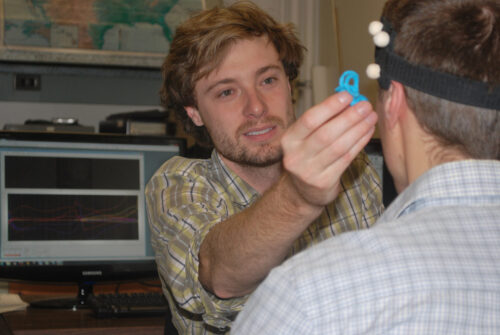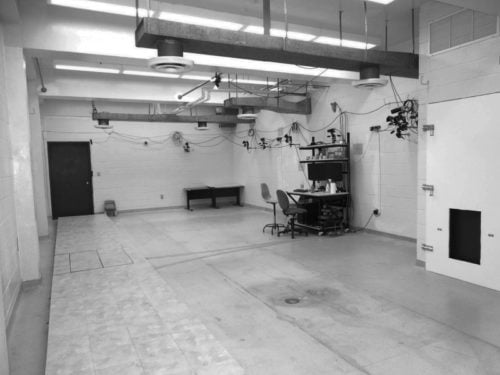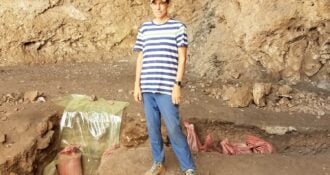Nathan Thompson explaining to a kinematic subject how head motion relates to the semicircular canal organs in the inner ear.
Nathan Thompson, PhD candidate from Stony Brook University, was awarded a Leakey Foundation research grant in spring of 2014 for his project entitled “Kinematics and evolution of upper body stability in hominins.”
Humans are unique among our primate relatives in how we move around our environments. With the adoption of bipedal locomotion, our ancestors were faced with the challenge of delicately balancing a heavy upper body atop a narrow pelvis. How we manage to accomplish this, without falling flat on our face at every step, is the focus of my dissertation work.
The human upper body functions to isolate the head from motion generated by the legs before it causes detriments to sensitive cranial organs. It also allows coordinated motion between segments to aid balance, stability, and efficiency during locomotion. I am investigating how the morphology of the pelvis, vertebral column, and head work together to mitigate motion in humans, and how morphological differences in our closest living relative, the chimpanzee, effect bipedal performance.
The Stony Brook Primate Locomotor Laboratory. Four high-speed cameras mounted on the back and right wall capture motion that occurs over the wooden runway (left). Embedded in the runway are four tri-axial force plates, which record the interaction between subjects and the ground.
Using high-speed cameras to record humans and chimpanzees walking, I can determine how much motion occurs between various regions of the trunk (pelvis, lumbar region, thorax and head). I also use small body-mounted accelerometers to measure high-speed, high-magnitude forces generated at heel strike, and how these forces are absorbed before they reach the head. By understanding how differences in trunk, vertebral and head morphology effect locomotion in humans and chimpanzees, we can ultimately hypothesize how differences seen in hominins would have effected early forms of bipedality.
Finally, my work seeks to elucidate the evolution of special cranial organs that govern aspects of locomotion, the semicircular canals. These organs have left their mark in many fossil mammals, including hominins. By understanding how differences in head motion reflect differences in semicircular canal morphology, we will be better equipped to use this information from the fossil record to reconstruct locomotion and behavior.
[iframe id=”https://www.youtube.com/embed/fnD19mGB-kc”]
Video above: A wireframe figure of a typical human and chimpanzee walking. Black lines represent the arms and legs. Colored shapes show the movements of the trunk and head (blue = pelvis, red = lumbar region, pink = thorax, and green = head). Three-dimensional motion of each region can then be calculated for each direction. The blue lines below each wireframe show the position in space of the pelvis in 3 anatomical planes.








Comments 0